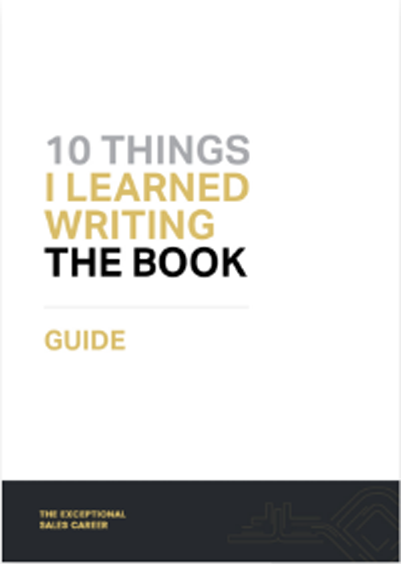Phil has a wonderfully direct approach to sales and business development, which carries over to his interviewing style. Phil is concise with his words, and told me when he didn’t think he could add value on several questions I asked. Phil’s focus on providing value to his prospects, clients and even interviewers has served him well in his career, and comes through strongly here.
This interview was recorded while Phil was at Revolut, but he has since moved on to other exciting, high-growth ventures.
You can read Phil’s full biography here
Jamie: Phil, when you look back on your sales career thus far, what have you found most fulfilling?
Phil: What immediately comes to mind is getting to know a product, because it’s pretty difficult to sell a product if you don’t believe in it. I’ve been lucky enough from my previous job at a company called Bloomreach, which is a high value, low volume type of product, and at Revolut now, to be in an environment that has strong products.
Jamie: What sort of things would you recommend evaluating in a company that you’re looking to join?
Phil: To be able to access the product yourself, whether that’s through signing up to it, which on the retail side would be easy, or through getting a demo. If that doesn’t work, then at the very least get a sense of what the market says about the product. The ideal scenario – if practically not that conceivable in all situations – is trying to find somebody who uses the product.
Jamie: What have you found the best thing about being in sales?
Phil: I think my strengths lie in client-facing activities; so being able to truly understand what the needs are of the person you’re speaking to. It is genuinely more gratifying when you have a more practical conversation. One of the big question marks of being in new business sales, which is what I did for three or four years at my previous job, is that you come into the room and the underlying inclination is to distrust you.
The sooner you can make it clear that the only outcome you really care about is getting to the bottom of their needs and whether you can help them or not, the better. You need to be engaging with people and to be able to really dig into their needs, and be honest as to whether you can help or not.
Jamie: It sounds like the most important part of a sales process is the discovery; asking good questions?
Phil: For me, certainly. I’ve always been a little bit on the unstructured side of things, and as you go into management roles, you have to change that. My favourite part is still being able to understand who I should be speaking to, how I should be speaking to them and eventually engaging with them to the point of working out whether we can help or not.
Jamie: What’s the worst thing about being in sales?
Phil:
The cliché that surrounds sales and the stigma that surrounds it means when you’re talking to people, it’s difficult to be regarded in a high-value way. I think people tend to assume that, whatever you’re trying to sell, you’re trying to sell it whether it’s the right thing or not. The salespeople that do that either don’t work out or end up in industries that are very shady or very uninteresting.
Jamie: You mentioned that Revolut, where you work now, has a B2C and a B2B business. What do you find is the biggest difference between being in B2B and B2C sales?
Phil:
The simplest way to put it is that in the B2C side, getting customers is easy, retaining customers is hard; on the B2B side, getting customers is hard, but retention is easy.
On the retail side, speaking of Revolut, the appetite for secondary accounts is already established. It’s free, or almost all of it is free. Being able to persuade someone to get the product in the first place is easy, in the same sense that it’s not difficult to get someone to download the Uber app. But it’s to get them to then use it in the necessary time frame – we all read those statistics required for that to happen – that’s hard. For the business side, businesses don’t just change bank accounts or business banking accounts on a whim. The threshold to persuade them to adopt your product is far higher because of the service they require. But once they’ve integrated, it’s fundamentally stickier because it is more integrated into several different processes rather than an individual person, who may use it as one of many accounts.
Jamie: So far, you’ve chosen to work for high growth organizations, is that a conscious choice?
Phil: It is a conscious choice. At the end of the day, this goes back to the stigma with sales. My reason for joining Revolut was to be able to be involved in more strategic decision making. Before, at Bloomreach, I was learning and was in a good environment. But our growth curve wasn’t as advanced as Revolut. I was getting frustrated that my ability to get properly involved in fundamentally changing the product, or being involved in more strategic decisions, was inherently limited.
Moving to Revolut, a high growth company where that particular business unit was far less mature, was appealing, but of course, it comes with risks. I didn’t join Revolut to be a sales lead and to run the sales team, but that’s how the cards fell. I’m enjoying it because it is strategic.
Jamie: How advantageous have you found being able to speak multiple languages in your career?
Phil: For me, not that much. It may become more useful, and it’s obviously an amazing thing to have in my back pocket. I know that if I turn around and say, “You know what? I want to go to the Germany office and set up a sales team there,” it will be difficult for anyone to deny me that opportunity. There are obviously many things I’m missing concerning existing connections in Germany, but it’s great to have that option. With Revolut, we don’t yet have many users in Germany. So, not yet, but I can certainly see it being a useful tool.
Jamie: How would you recommend organizations best compensate their salespeople?
Phil: There should definitely be a commission model. Some businesses are trying to toy with the idea that a commission model doesn’t actually work, but I’m far from convinced. That structure is required, whether that’s a 50/50 or 40/60 split. Wherever possible, the commission should be uncapped. Capped commissions are a bad idea, with very few exceptions. I think that once those things are out of the way, compensating salespeople is actually far more straightforward than almost any other operational element of the business because it has a linear relationship to earning.
In my previous business, each rep would probably do about 5 to 10 deals a year, with an average deal value of $500k. In that world, an efficient structure was simply a function of revenue. “If you bring in $100k grand a year, we’ll pay you 5%-10% on that.” Personally, I think that it tends to be a pretty self-fulfilling prophecy. Revolut, in particular, is a very intriguing one and is testament to the differences between B2B or the B2C. We have six pricing plans for the business product, two of which are free; one of which is £7, and one that’s £1,000. None of those has any commitment beyond a month. Without that predictability of revenue and with wildly fluctuating retention rates in different sectors and regions, it’s much more difficult to compensate a team consistently.
Jamie: What elements of culture make a sales organization successful?
Phil: Openness. You have to instil the competitive spirit, and that always needs to be the undertone; otherwise, you begin to find it difficult to make difficult decisions.
I’ve been in sales organizations with people who definitely should have been fired, but haven’t because they’re lovely people that everyone gets on with. Sure, you can make the argument that the base-to-salary ratio is done in such a way that the person isn’t actually costing the business money, but it’s clearly not very efficient, and it drags other people down.
You need to have a setup where results matter, but not one that encourages fear and ultimately bad behaviour. It’s difficult to find that balance.
Jamie: If you want to go and work for a high-growth challenging organization like Revolut, how do you get your foot in the door?
Phil: Through someone you know really. My contact said, “Why don’t you come and join,” so I explored that, truth be told, with no interest in joining. It was my first real foray into another job outside of BloomReach. It was the right time, where I knew I had to start looking because I was beginning to get too comfortable. I just thought to myself, there’s no way I’m taking the first job I get offered. Of course, Revolut, let’s be very clear, had a dreadful reputation. I thought, “No way would I join this business,” but I went through an interview process with no stress, and the further down the process I got, which wasn’t a very long process, I began to think, “Well, why not?”
You have to sell yourself if you’re going to go for a sales organization role. That’s so critical because, at the end of the day, you are the product. It’s a hugely clichéd sentiment, but it’s one that I think people forget. People aren’t listening to me verbalizing a specification sheet, they’re listening to me. Someone once told me that “people only buy from people they like” and I certainly think there’s something to this.
If you’re going for an entry-level role, it’s a bit different, but remember: be forward. Don’t be shy. Going through the website, through LinkedIn, find people, and message them. That is so important. Otherwise, it would stand to reason that you won’t be good at the job you are applying for.
Jamie: Do you feel like one of your competitive advantages as a salesperson is that you get to “no’s” quicker?
Phil:
It is absolutely critical to be able to move on quickly and to be able to decide whether or not to pursue a deal, because people waste so much time on deals that are never going to close. I don’t like messing about and so at a certain juncture early in the conversation, I will dig right to the key question of whether we can help.
A good example from the other day; we had someone reach out to us, and they didn’t provide the nature of business on the outset. When I spoke to them, he said that he works for a hedge fund. We don’t currently support hedge funds because it’s too complicated. What do you do? I’m not going to hang up on the caller, but nor am I going to continue a pitch as if nothing happened. If I see right at the beginning, I’d say, “Look, you mentioned you work for a hedge fund, it’s important for you to know that right now we don’t support hedge funds.” It sounds obvious, but you’d be amazed how many people will press on regardless.
Jamie: What advice would you give to an aspiring salesperson?
Phil: I would probably tell them “You have to be very careful” and it goes back to the stigma point about the ethics of sales. I think that you need to do away with any fear of being an inconvenience for somebody. That’s really important. I’m thinking of someone in my previous job as well, he was a very experienced sales guy, really impressive, and very good at his job. We were trying to chase someone down for a key decision, and when he didn’t pick up, I left a message and settled in to wait for a callback. He said, “Call him again,” and I did that three times. I’m blowing this person’s phone up, and he’s like, “Well, at the end of the day, if he’s serious about buying, then he will pick up. There’s no other way.” He was right. It’s anecdotal, but he was right. So, if you are too shy and too secretly polite, it’s not for you. You need to be able to be quite forceful and have a bit of intensity.
On the other end of the spectrum, it’s critical to know that lying will never make you win. You will lose. If you try and con somebody, you make get a few rungs up the ladder, but it won’t last long until people realize this awful bloke is selling his best-case version of the two-year roadmap, not the actual product. I’ve seen people be fired for that exact behaviour.
Know the product, sell that product rather than the fantasy, and sell it in ways that are creative and intelligent, but only when it’s truly aligned with the customer’s need.
Jamie: Can you run me through a time when you didn’t make a sale, but it taught you something?
Phil: A colleague of mine started speaking to the major sportswear label in Germany. He and the product team, and indeed the business as a whole, pulled out all the stops. We basically rebuilt the product for them. It was a brilliant experience, and a testament to collaboration Bloomreach encouraged – and that a good salesperson is responsible for driving. We were all hands to the pump, and we built this epic RFP, covering all of their bases and were actually building the product, not just screenshots of it, a real product. Then right at the 11th hour, we lost it. It was just us against a competitor, and it would obviously have been a big thing for our business. As it turns out, I think that was probably the best thing that happened to us – it was a gut-punch, of course, but it helped us rethink our product, and we would likely have been entirely swamped by a demanding customer’s needs around a product that we were only just beginning to understand ourselves. Furthermore, it meant that we had a great solidarity experience for the team and our product got a lot better because the feedback loop between sales and the feedback from the customer had become so strong.
It also made me reconsider a major misconception as to what marketing does as well.
The word “marketing” is perceived to be, “Here’s a product. Go and tell people about it,” much like for sales, it’s “go sell it.” That’s the fundamental misunderstanding of any good marketing or sales organization. You need to have a constant feedback loop, incorporating qualitative and quantitative data for ongoing analysis; that feedback into your product organization is invaluable.
Lo and behold, a year later, we had landed some of our biggest ever customers.
Jamie: Have you ever made a sale that shows off the skills and knowledge you’ve developed thus far?
Phil: My favourite was probably a very simple example, which was an existing business sale to the holding company of a huge home improvement group. My new-business colleague had originally signed them up for a range of products, and it was my job to expand the deployment of existing products, and add new ones. This particular colleague is one of the best salespeople I’ve ever worked with, but the one area he was willing to concede on more was on discounting – this is by no means a flaw, and depends on a wide range of variables. But it meant that my biggest challenge was to re-condition this customer to understand that I wasn’t going to move an inch on price, without damaging the relationship.
Pricing is often a bit of a dark art, but I prefer transparency here – so rather than have a back-and-forth of them asking me to, “see what I can do,” I simply made them a custom rate-card. This made it very difficult for their procurement team to make a case for essentially arbitrary discounting because I’d clearly spelt out what the unit costs were. This eventually allowed me to go over their heads, to the customer’s digital leadership team, who needed the product ASAP, and tell them that it was time for them to step in – whilst being able to prove I’d been open throughout.
Jamie: I want to dig into that mechanism for avoiding discounts. Do you think transparency in pricing helps with that?
Phil: Pricing in enterprise sales is radically different to, say, SME or even consumer pricing, because of the wide range of your product’s actual value to that company.
There are broadly two different approaches to pricing. One is that you just have a cost of the product, and that’s what you charge, plus a fixed margin on top of that. That approach means the salesperson has limited discretionary pricing involvement. On the other hand, you primarily price in line with a quantified business case – obviously, you have to cover costs (and even then, not always, depending on “soft” benefits, like brand, and referral value) but beyond that, it’s up to a sales pro to determine what the highest sum would be where the client still feels they’re getting value – that’s the game.
The one thing that I do love at Revolut right now is selling a mid-cap-focused FX product. That will be the part of the product we’re charging £10,000+ a year, and that is where custom pricing comes more into it. That’s where my strength is. Operationalizing how to direct sell a fixed price product is a different, and interesting, challenge.
END



